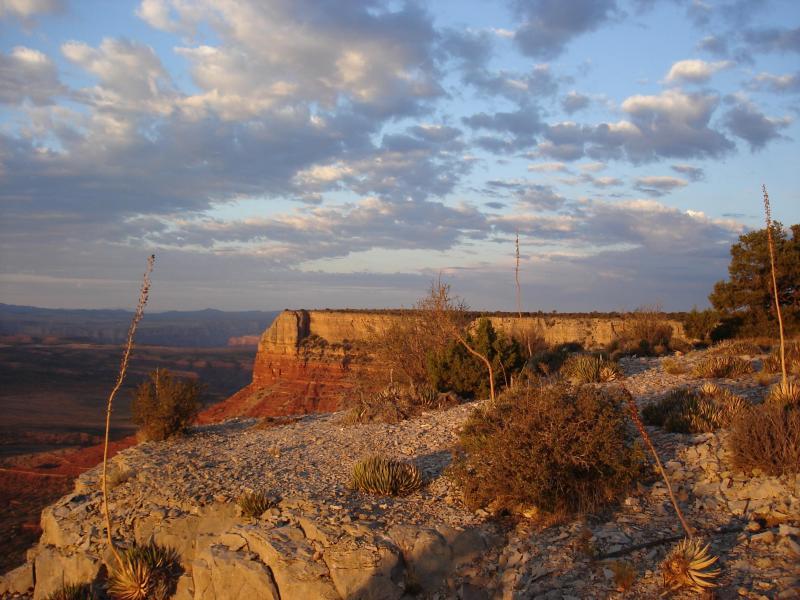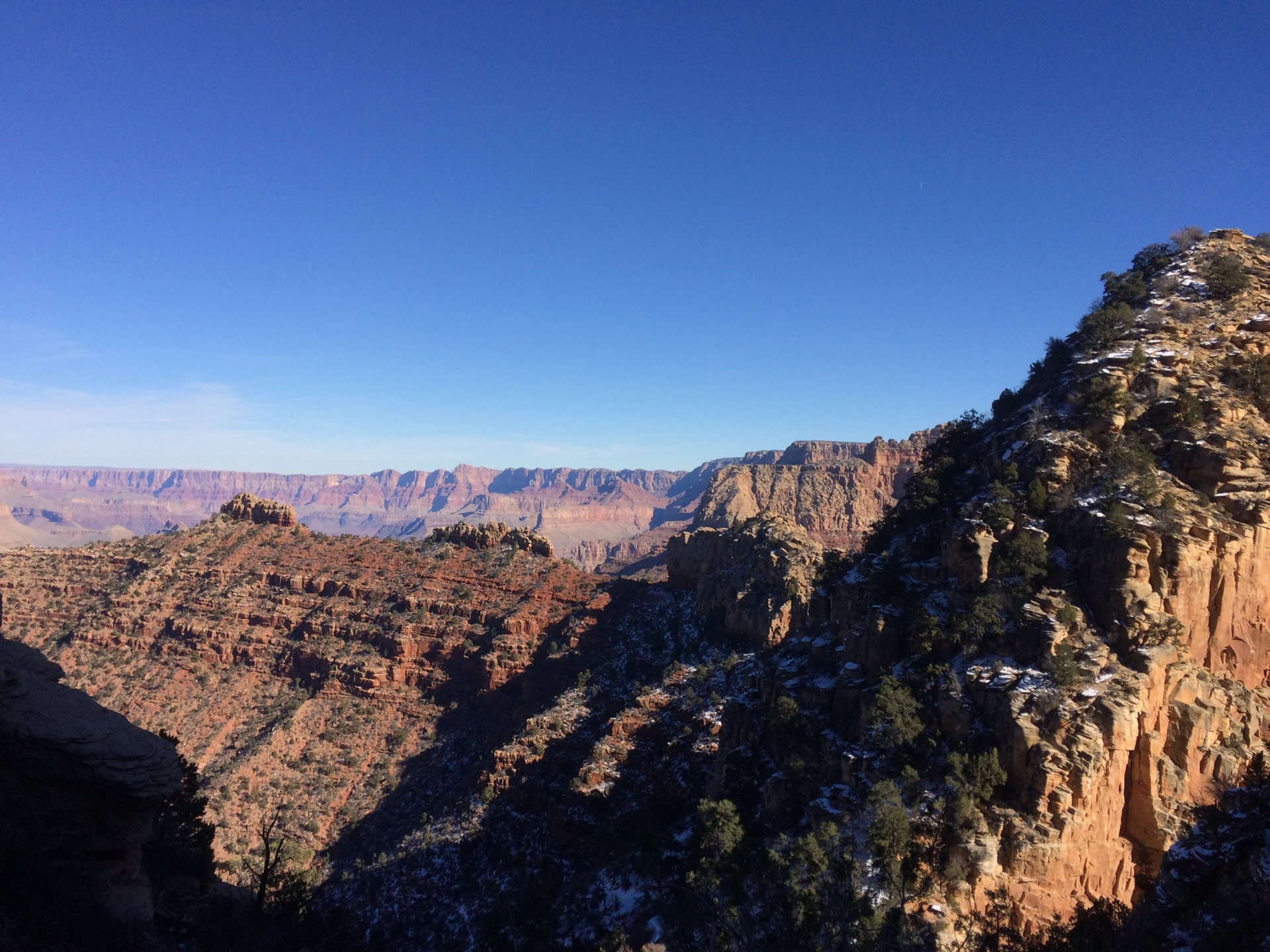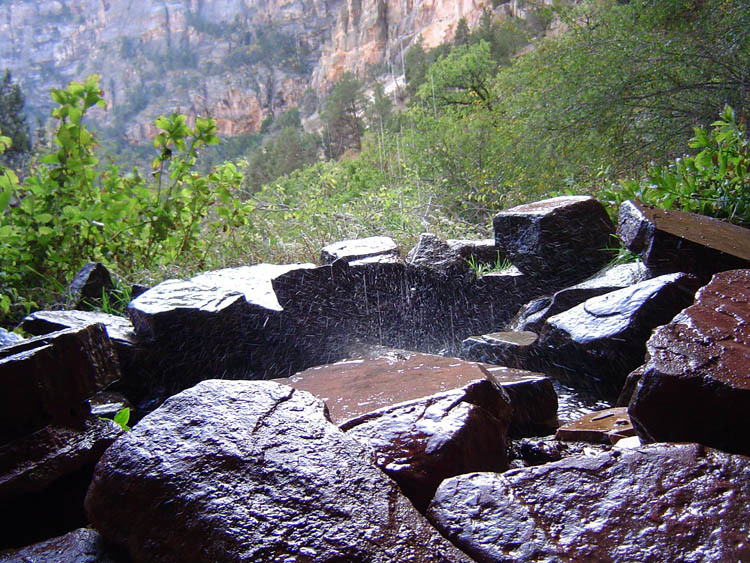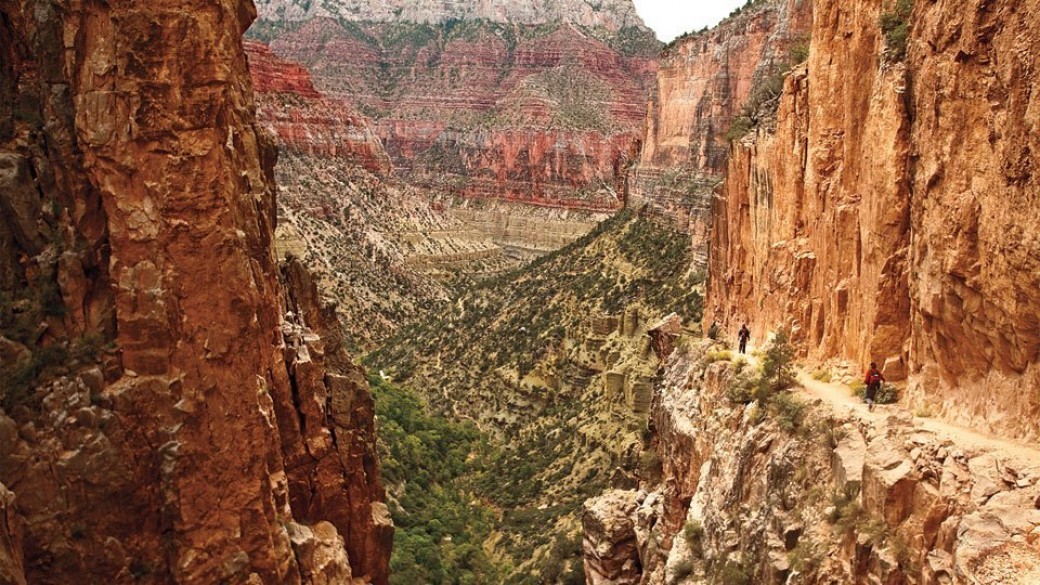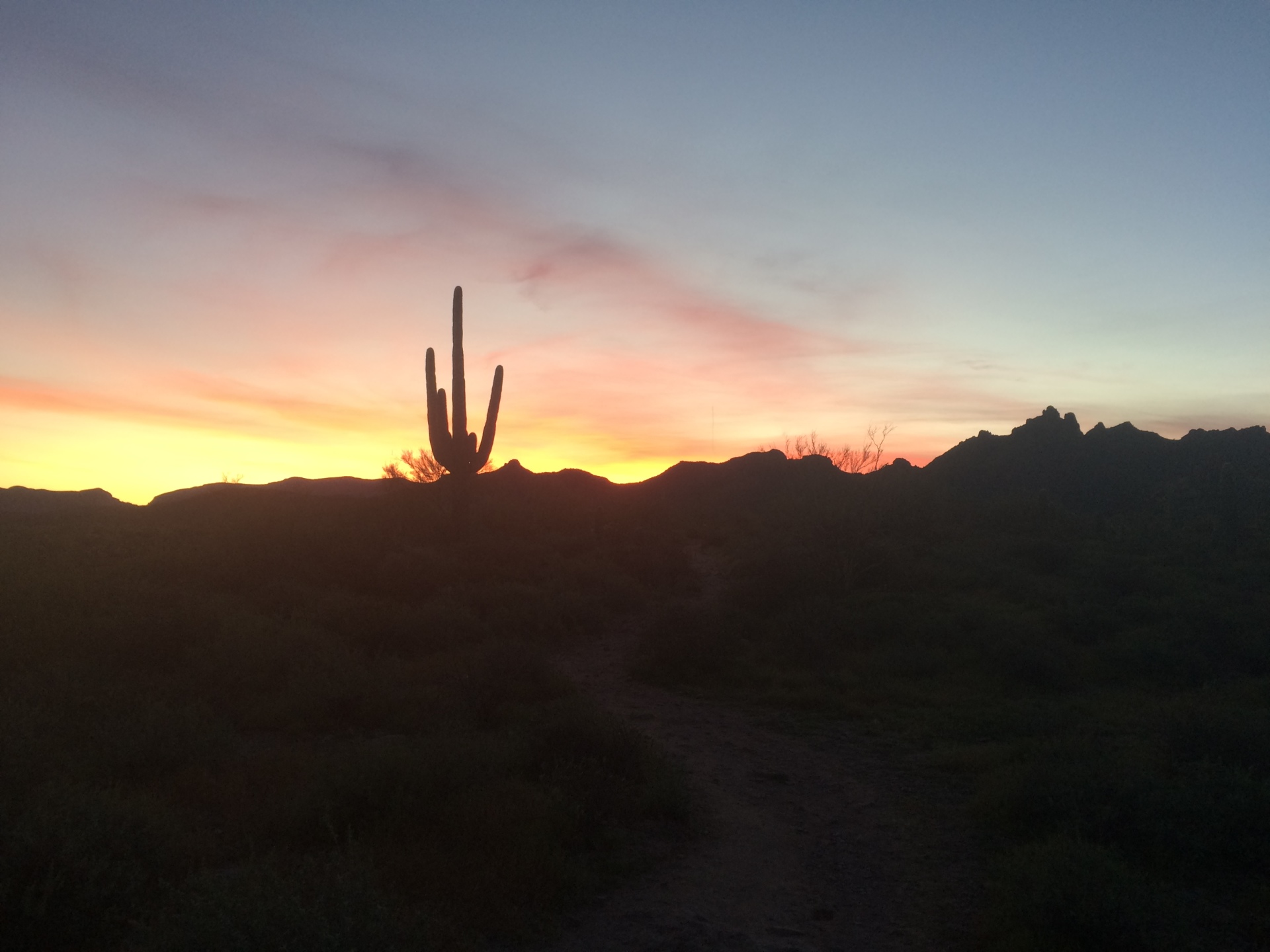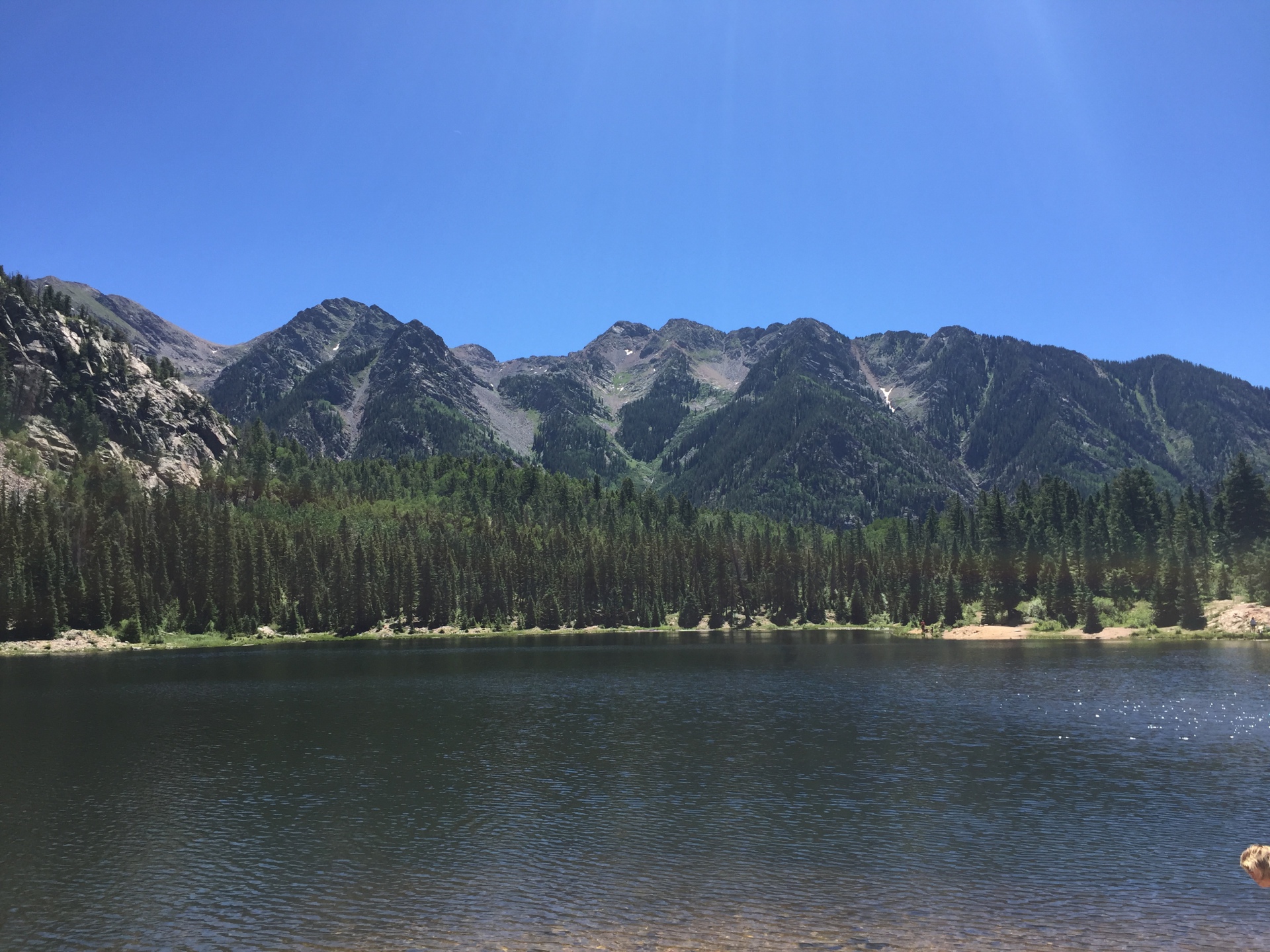by The Goat | Aug 27, 2019 | Grand Canyon, Hiking
Why did Grand Canyon become a National Park?
The answer to this question seems obvious. Simply put, it is the Grandest Canyon on the planet. Scenery aside, Grand Canyon is a treasure trove of resources that scream for preservation. To truly answer the question though, we must delve into why any National Park exists. It’s not just the scenery that makes Grand Canyon famous, but the pioneers that preserved it. The story of Grand Canyon’s journey to National Park status is as deep and wide as the canyon itself. Henceforth, come as The Goat tells the tale of the how the National Parks, and Grand Canyon itself, came to be.
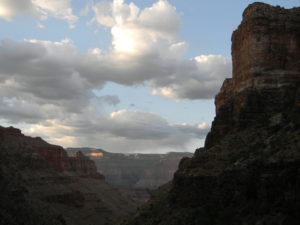
Why are there ANY National Parks?
A National Park is an area that has been set aside for preservation and public use by an act of the President or Congress. Most importantly, it is closed to industry and private development. However, the story of the National Parks begins, as many stories in the development of the Western United States. Pioneers, prospectors, and the railroad were the driving force.
The purchase of land by the US Government in the early 1800’s opened the land. In these wide-open spaces, places were discovered unlike any on Earth. Soaring mountains, deep canyons, active volcanoes, and extraordinary landscapes were the norm. The discovery of gold in California sparked a massive westward expansion in 1849, and flooded the wild lands with pioneers and opportunists. Many of those that didn’t strike it rich realized the potential for preservation of these beautiful places.
Political Movement and Conservation
In the 1870’s, a political movement known as “democratic liberalism” had washed over the nation. Americans were concerned with the perceived ravages of unchecked capitalism, and Congress responded. The Congress enacted the Forest Service Act, one of many new laws passed aimed at social reform. The new law allowed the Federal Government to set aside areas like Yellowstone, Yosemite, and Sequoia National Forest for protection.
Yellowstone became the first National Park in 1872, and the party had just begun. Using the Forest Service Act, the Yellowstone National Park Act was cemented into law in March of that year, and kicked off a generation of conservation that created many of our most famous National Parks.
The First National Parks
Yellowstone was, of course, the first National Park created in 1872. However, many other parks came before Grand Canyon. Sequoia was set aside for protection in 1890, along with Yosemite. Grand Canyon National Park was created in 1919, but by then, Rocky Mountain, Crater Lake, and Hawaii Volcanoes among others had already been established.
The Antiquities Act
In 1906, Congress created the Antiquities Act. The act gave the President power to establish National Monuments, by using land already owned by the Federal Government. It paved the way for the creation of the National Park Service in 1916, and the NPS now manages 61 National Parks, and many more National Monuments.

Grand Canyon Becomes a National Park
The cultural history of Grand Canyon dates back several millennia, but the first Europeans to arrive in the Grand Canyon region came after the Mexican-American War of the 1840’s. Trade and transportation routes opened up in the American Southwest and began to approach the North and South Rims of Grand Canyon.
The story of Grand Canyon becoming a National Park begins, as many stories in the settlement and development of the Western United States, with pioneers, prospectors, and the railroad. Grand Canyon was an unknown wilderness for the first five million years of its existence, but that was about to change.
Early Pioneers and Exploration
Early Pioneers in the area included Bill Bass and Ralph Cameron. Louis Boucher, better known as “The Hermit”, built a wonderful trail into the canyon’s depths. John Wesley Powell, “The Father of the American Southwest”, was the first to navigate the Colorado River from Lee’s Ferry to Pearce Ferry in 1869. His book, The Exploration of the Colorado River and its Canyons, documents the journey.
Powell’s voyage was important in mapping Grand Canyon. It was was the key to unlocking the unknown. There was little known about the inner canyon before. Powell took 11 men on the expedition, and 8 finished the journey. One man became ill, and another injured himself. Two men gave up, and climbed out of the canyon near Toroweap. They were never seen again, and it is unknown what happened to them.
Powell was the head of the US Geological Survey at the time. His expedition opened the canyon for more intensive geologic research, and scientists from around the world came to study the canyon. The rocks in Grand Canyon hold many secrets. Two billion years of Earth’s history is contained in its walls. Above all, Grand Canyon is a window into time.
Mining and The Railroad Come to Grand Canyon
The Union and Pacific Railroad arrived in the 1870’s, and along with the Santa Fe Railroad began to provide transportation to and from Grand Canyon for tourism and industry. Several mining claims were established in the canyon, most notably the Last Chance mine below Horseshoe Mesa. Last Chance was one of the only mines that was profitable. The profits, however, were short-lived.
Most prospectors in Grand Canyon quickly realized that they could make far more money with tourism, and improved routes down into the canyon. Mules and horses carried tourists and their trappings down into the canyon, where a camp awaited. After that, tourism grew quickly, and soon the railroad companies became interested.
The first train to arrive at Grand Canyon’s South Rim pulled up in 1901. El Tovar Hotel was completed in 1904, and was immediately heralded as the finest accommodation in the west. The railroad stop literally paved the way for the development and growth of the burgeoning park, and people flocked to take in the views.
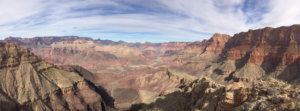
Grand Canyon Becomes Protected Land
First, Grand Canyon was protected under the Forest Act in 1882, to the chagrin of many would-be industrialists. Then, President Theodore Roosevelt used the Antiquities Act to establish Grand Canyon National Monument in 1908. The newly created power protected the canyon from any and all private claims. Finally, Senator Henry Ashurst of Arizona introduced the bill that officially made the Grand Canyon a National Park in 1919. It is now one of the most popular places on Earth.
Grand Canyon has seen tens of millions of visitors since its designation. In 2018, visitation hit an all-time high at over 6.4 million, and it is the 8th-most visited Park in the system. National Parks such as Golden Gate Bridge and the Lincoln Memorial are also designated National Parks, and places such as these the most total visitation. After that, Grand Canyon sits behind only Great Smoky Mountains in terms of the natural National Parks.
Going Guided
Hiking and exploring Grand Canyon, or any of the National Parks, is a special experience. Although it is possible to see these places yourself, hiring a guide is a great idea. For instance, guiding services provide logistical support, and plan everything for your best possible trip. They provide a great safety net on the trail, and are trained in backcountry medicine. Above all, they provide a depth of knowledge of the region that turns a walk into a true adventure.
Blue Marble Adventure GeoTourism provides all of the support you need, and pairs that with expert geologist/guides. Our backcountry meals use fresh ingredients, and are planned by a professional chef. Furthermore, we provide top-of-the-line gear and passion for the places we explore. In conclusion, you can visit National Parks, but going with a guide can create and even more memorable experience. Don’t be shy, and call us!
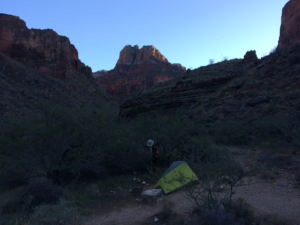
The Goat’s Final Word
As you can see, the real answer of how Grand Canyon became a National Park is not so obvious. The question why is an obvious answer, but how is the real answer. The scenery and beauty at Grand Canyon are magnificent. In other words, the clear need to preserve this special place is made obvious the moment you approach the rim. However, it took gumption and years of political action that brought us the National Parks. Therefore, visit the National Parks. They are magical places. Marvel in the surroundings, and appreciate how they came to be.
Why did Grand Canyon become a National Park? The answer is simple. How though? Fortitude. Commitment. Perseverance. Dedication to a cause. The actions of a relentless band of rebels. The same actions and fortitude that carved the entire National Park system. In conclusion, action.
Read our blog!
For adventure hiking vacations in a geologic time machine, see our epic tours in Grand Canyon, Utah, and Arizona!
For geological musings read The Goat’s geology blog.
Follow us on Facebook and Instagram
Explore Further, Be Wild, See Through Time — Blue Marble Adventure GeoTourism
by The Goat | Aug 27, 2019 | Grand Canyon, Hiking
What is the best hiking season in Grand Canyon?
Many of our hikers, clients, and friends are asking about our various destinations and the best time to hit them. Many of those questions revolve around Grand Canyon National Park, one of our most favorite places, and one of the most complex to explain. The reason for this is Grand Canyon’s dramatic elevation changes from rim to river, almost 7000 feet from places on the North Rim. Any given day there are 40 degree differences between the highest and lowest points. Therefore, several answers exist. The bottom line is, however, that there is a hike for every season here. In fact, depending on how adventurous you want to get, there may be some incredible adventures waiting in the off-seasons.
People always want to know the best season to visit Grand Canyon, so here is The Goat’s answer, packaged neatly as usual in a “more information than you thought you were going to get” kind of way. So ask the question, what is the best hiking season in Grand Canyon. Go ahead, ask it. What is the best hiking season in Grand Canyon. Well then, let us hike through the seasons in Grand Canyon!

What is the best time to hike ON the rim?
South Rim
The busiest season in Grand Canyon is the summer, when school is out and tourists abound. Although temperatures can get into the high 80’s and 90’s during the summer on South Rim, it is still pleasant and spectacular hiking, not to mention easy for all skill levels. South Rim amenities are open year-round, and though it receives some snow in the winter, it is generally accessible and fabulous year-round.
Winter on the South Rim can bring snow and cooler temperatures. However, most days are sunny and generally warm for winter. Temperatures on the rim can get into the 60s and 70s some days, although mornings are typically chilly. Hiking in winter on the South Rim may some days require shoe spikes or even snowshoes/crampons. The snow tends to get packed down, which can make trail conditions icy. Just be aware and don’t act a fool!
North Rim
Grand Canyon’s North Rim is absolutely prime in the summertime. Rolling aspen forests grace the approach from Jacob Lake, and oftentimes wildlife abounds. North Rim is far less crowded than the South Rim, making it attractive for people looking to lose the crowds. Like South Rim, hiking along the rim provides great vistas, but with a more contemplative feel. The waterways that have carved Grand Canyon flow mostly from the north, therefore the North Rim is more recessed. In contrast to South Rim with its abrupt cliffs dropping down to the river, North Rim’s descent is more gradual. North Rim is an exciting wilderness experience, and is our “summer adventure of choice” in Grand Canyon.
The North Rim is less accessible in the winter. Roads and amenities are generally open from May 15 – October 15. After October 15, the ranger station at the entrance is not staffed, and the gate is closed. Everything behind the station closes as well, including campgrounds and the Visitor’s Center. Accessing the park must be done on foot, which can require XC skies or snowshoes. Motorized travel is not allowed.
North Rim can receive several feet of snow in the winter. It is, after all, at almost 9,000 feet above sea level, meaning in terms of elevation you are essentially at the ski lifts of many mountains in Colorado or Utah. Winter adventures can be had, but should only be attempted with appropriate gear, acute knowledge of terrain, and winter hiking/camping experience. The North Rim is also much less visited, making it a howling wilderness in the cold months.
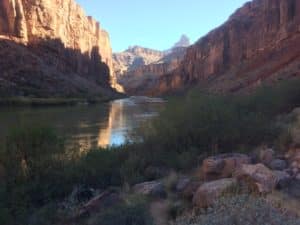
What is the best time to hike below the rim?
Hiking below the rim in Grand Canyon is the best way to experience its grandeur. However, summer can be hot below both rims, and people put themselves in serious danger hiking during the heat of the day in summer. Even a relatively short day hike in July or August can be unpleasantly hot. If you choose to hike below the rim in summer, be sure to start very, very early (like 4am early if you plan to reach the river) to avoid the midday heat and bring plenty of water. The best seasons to attempt day hikes below the rim are spring and fall. Never attempt to hike rim-to-river and back in one day.
Winter months bring excellent hiking conditions. Trails can be somewhat icy at times, but nothing that a decent pair of spikes and a bit of caution can’t handle. Winter is an exceptionally unique time at the canyon, with white snow contrasting against the multi-hues rocks of the gorge. South Rim hikes are generally accessible in winter, and are quite enjoyable. Day hiking from North Rim in the winter is a tougher proposition, given the fact that the roads close. You may access North Rim for hiking purposes in the winter, but you will need to hike the 18 miles in from the entrance station.
What is the best time to backpack in Grand Canyon?
As previously stated, summer can be quite warm below the rim in Grand Canyon. In fact, Inner Gorge temperatures have been known to register at over 130 degrees in the midday sun, making it at best unpleasant, and at worst deadly. Similar to day hikes, backpacking in Grand Canyon during the summer requires early start times and close attention to water intake.
Spring, autumn, and winter months bring fabulous backpacking opportunities; while it stays very cool (20-40 degrees) on the rim, perfect temperatures abound (50-60 degrees) in the Inner Gorge. In addition, permits are more easily procured as few people are applying for them. For a truly grand backpacking experience, plan your trip any time from September-April. May can be good too, but it does begin to get warm later in the month.
What is the best time to hike rim-to-rim?
Backpacking or hiking rim-to-rim is on the bucket list of many hikers all over the world. There are a several factors that make this an outstanding adventure. The most popular route is North Kaibab to South Bright Angel, with stopovers at Cottonwood Creek, Bright Angel Campground or Phantom Ranch, and Indian Gardens. The trail, traverses a part of Grand Canyon with some shade, running springs, developed campsites with running water (not available in the winter), and provides a time of year wherein the crisp waters of the Colorado are highly refreshing.
A truly outstanding route includes a pack rafting trip down the Colorado River, connecting North and South Bass Trails. The hike traverses the route carved by William Wallace Bass, and early pioneer in Grand Canyon. This backpacking trip typically takes 6 or more days, and is one of the most thrilling non-technical hiking adventures in the National Park.
It is easier logistically to do Rim-to Rim in the summer. However, permits to stay at Bright Angel Campground or Phantom Ranch can be tough to come by. Also, services at North Rim are open for a limited part of the season, and trails can even be totally inaccessible if there is snow, which occurs regularly in the cooler months.
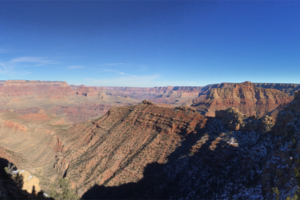
Going Guided
Hiking and exploring Grand Canyon, or any of the National Parks, is a special experience. Although it is possible to see these places yourself, hiring a guide is a great idea. For instance, guiding services provide logistical support, and plan everything for your best possible trip. They provide a great safety net on the trail, and are trained in backcountry medicine. Above all, they provide a depth of knowledge of the region that turns a walk into a true adventure.
Blue Marble Adventure GeoTourism provides all of the support you need, and pairs that with expert geologist/guides. Our backcountry meals use fresh ingredients, and are planned by a professional chef. Furthermore, we provide top-of-the-line gear and passion for the places we explore. In conclusion, you can visit National Parks, but going with a guide can create and even more memorable experience. Don’t be shy, and call us!
The Goat’s Final Word
You wanted to know the best season to hike in Grand Canyon, and there you have it! There is a hike for every season and every hiker here. Hikes along the rim are best in the warmer months, spring-fall. Hiking on the rim can be cool in winter, bring a good jacket. Backpacking trips are best done fall-spring. Day hikes in Grand Canyon are best done in spring and fall, and in summer you should start early. Winter can bring some snow and ice, so you may way to pack a pair of spikes if you are hiking during the cold season. See you on the trail!
Read our blog!
For adventure hiking vacations in a geologic time machine, see our epic tours in Grand Canyon, Utah, and Arizona!
For geological musings read The Goat’s geology blog.
Follow us on Facebook and Instagram
Explore Further, Be Wild, See Through Time — Blue Marble Adventure GeoTourism
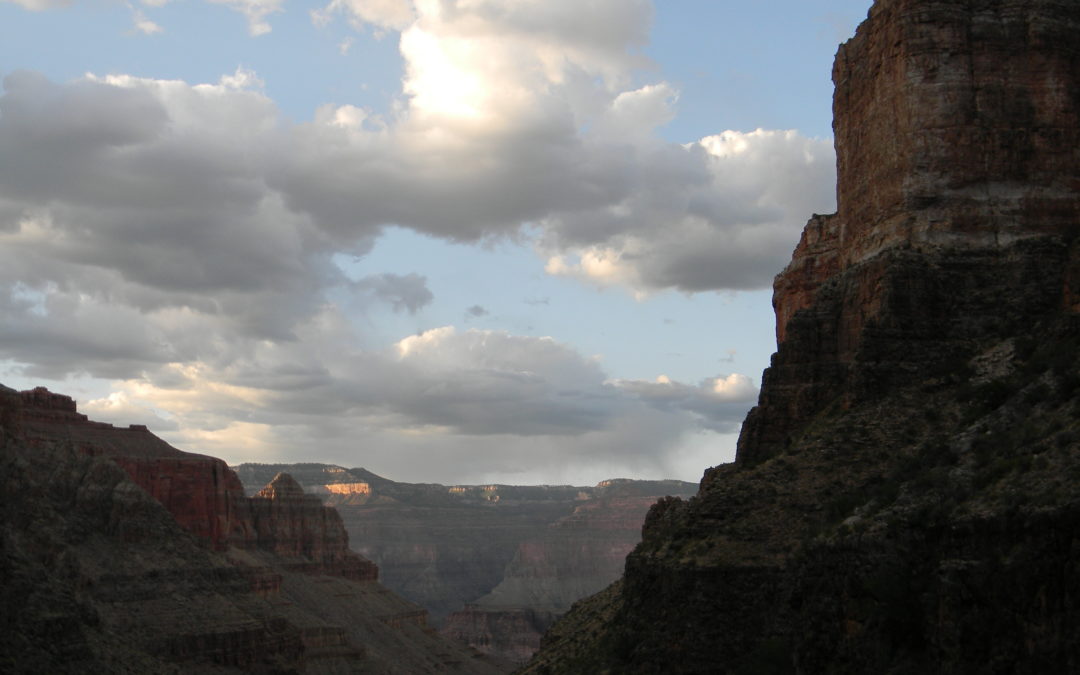
by The Goat | Aug 27, 2019 | Grand Canyon, Hiking
How long does it take to hike South Kaibab?
The South Kaibab Trail is perhaps one of the most popular, well-known, and beautiful trails not just in Grand Canyon, but in the entire National Park System. Of the over 6 million people that visited Grand Canyon in 2016, nearly 10% set foot on South Kaibab, each with their own intentions. Like any hike, you can spend 2 minutes or 2 days on the trail, it’s really up to you. But since we field this question with some regularity, we wanted to dive into a bit more detail.
South Kaibab starts from its perch at over 7,000 feet above sea level just east of the South Rim Visitor’s Center at Grand Canyon. Most folks hop on the park shuttle to get to the trailhead, as passenger car parking at the trailhead is not permitted. The following are the general specs for the trail in its entirety:
Length: 6.9 miles to the Colorado River
Elevation Loss: 4,700 feet
Zone: Corridor
Difficulty: Keep Reading
Like any trail in Grand Canyon, South Kaibab presents outlandish scenery and unique challenges. The most challenging aspect of any hike in Grand Canyon is regaining the elevation that you lose. It is akin to hiking a mountain in reverse, and many visitors breeze a few miles into Grand Canyon before realizing that they need to get back to the rim. South Kaibab is in the Corridor Zone, which means it is patrolled by NPS Rangers, is well-maintained, and you have a high likelihood of seeing other hikers on the trail. The trail is generally pretty wide, route-finding is not something that one need worry about, and there are even facilities along the trail should nature call.
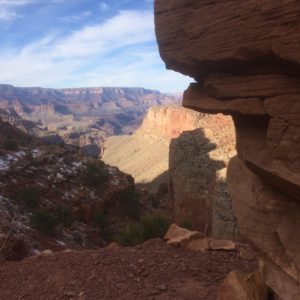
So You Want to Hike South Kaibab….
There are a couple of excellent day hike destinations along South Kaibab, as we (along with NPS and anyone who is not insane) do not recommend going to rim-to-river and back in one day. Here they are with times estimated for the average hiker in good weather:
Ooh-Ahh Point: 1.5 miles round-trip to a spectacular overlook of the Colorado River. (2 hours)
The Tipoff: 6 miles round-trip to the top of the Redwall Limestone and the shaded oasis of Bright Angel Creek. This is one of the most popular day hikes in Grand Canyon ( 6 hours)
Cedar Ridge: 3 miles round trip to a stunning overlook and fabulous respite in the Hermit Shale (3 hours)
Now, more to the point, the hike down South Kaibab is a more direct and therefore steeper route than the at-times meandering nature of its neighbor Bright Angel. This also makes it more challenging, especially on the way up. Though we never recommend that even the most fit hikers in the best conditions attempt this hike in one day, we will quote you a time of at least 11 hours to get to the river and return to the rim. The lack of water, lack of shade, and steep relief make this an arduous single-day adventure, and should not be undertaken.
Want to know more about hiking South Kaibab?
As always, the best way to see Grand Canyon and the South Kaibab Trail is on one of our guided tours, where you will be treated to the epic scenery along with the fascinating story of how this canyon was built layer by world famous layer.
Going Guided
Hiking and exploring Grand Canyon, or any of the National Parks, is a special experience. Although it is possible to see these places yourself, hiring a guide is a great idea. For instance, guiding services provide logistical support, and plan everything for your best possible trip. They provide a great safety net on the trail, and are trained in backcountry medicine. Above all, they provide a depth of knowledge of the region that turns a walk into a true adventure.
Blue Marble Adventure GeoTourism provides all of the support you need, and pairs that with expert geologist/guides. Our backcountry meals use fresh ingredients, and are planned by a professional chef. Furthermore, we provide top-of-the-line gear and passion for the places we explore. In conclusion, you can visit National Parks, but going with a guide can create and even more memorable experience. Don’t be shy, and call us!
Read our blog!
For adventure hiking vacations in a geologic time machine, see our epic tours in Grand Canyon, Utah, and Arizona!
For geological musings read The Goat’s geology blog.
Follow us on Facebookand Instagram
Explore Further, Be Wild, See Through Time — Blue Marble Adventure GeoTourism
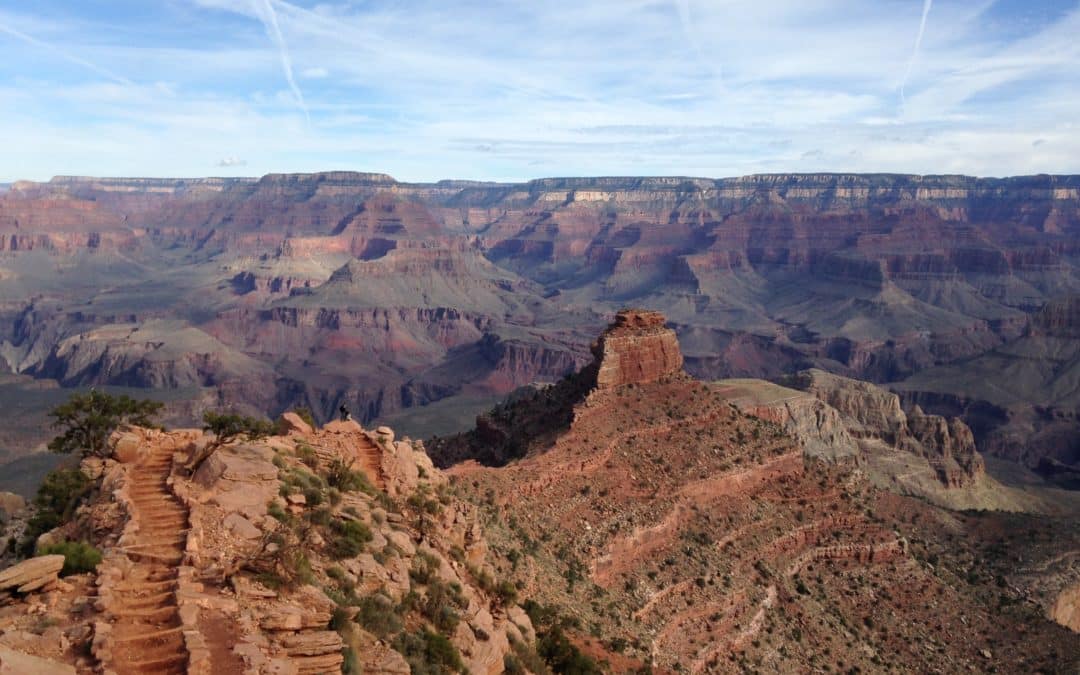
by The Goat | Aug 27, 2019 | Grand Canyon, Hiking
How long does it take to Hike
Rim-to-Rim in the Grand Canyon
Of the many bucket-list items that people set for themselves, hiking rim-to-rim at Grand Canyon National Park is among the most cited with most anybody interested in hiking. Ask anyone who has done it, and they will tell you that it is a true badge of honor, an indelible memory, and the experience of a lifetime. A rim-to-rim hike is rigorous, rewarding, and right within your grasp should you be willing to take the challenge. Among the many questions about this epic adventure, the most asked question about a rim-to-rim hike typically is: how long does it take?
That question, although simple, has a somewhat complicated answer that depends almost solely upon the person asking it. A rim-to-rim hike in Grand Canyon can quite literally take anywhere from several hours (for the ultra-hardcore only), to several days (for the more scenically, less insanely inclined).
North Kaibab to Bright Angel Trail
The most traveled path on a rim-to-rim at Grand Canyon takes you down from the North Rim descending the North Kaibab Trail. Camp is made at the Colorado River before heading up either the South Kaibab or Bright Angel Trails, emerging at the South Rim. The total mileage is roughly 18.5 miles from start-to-finish, and trust us when we say that those miles will make you earn it, especially on the way back up.
Typically, the rim-to-rim hiker will make it down to the Colorado River in one day, and back up to the rim in two days, splitting up the arduous hike out into two days. This is especially true when backpacking as most do on rim-to-rim sojourns, as carrying your entire life on your back can make for a challenging trudge. The uphill side of Grand Canyon is particularly relentless, no matter your skill level, and there are only a few places where hikers can safely cross the river without a pack raft or other floating device, so this somewhat limits your options.
In fact, North Kaibab to Bright Angel or South Kaibab is the only officially recognized rim-to-rim trail by the National Park Service. All other rim-to-rim hikes are considered routes, and are recommended for only highly experienced Grand Canyon hikers and/or guide services. A very popular alternative to rim-to-rim, is rim-to-river and back, which takes just over 9 hours and covers 21 miles.
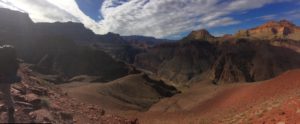
North Bass to South Bass Trail
Our personal favorite trip takes five days and utilizes the handy pack raft. Starting at the South Bass Trailhead, we embark on one of the most fabulous backpacking trips Grand Canyon has to offer. The Bass Trails connect in central Grand Canyon west of the Great Scenic Divide, a true geological marker in the Grand Canyon that separates the open sweeping vistas of temples and buttes from the more stark plateau country and Inner Gorge. South and North Bass are located in the latter, west of the divide, and views from the trail illustrate some of Grand Canyon’s most complex geology and geologic history.
After camping at one of the most spectacular white sand beaches in Grand Canyon, we break out the old pack raft for an epic flat through Bass Rapids, beaching on the north side and following a faint route up the North Bass Trail, one of the most challenging developed not just in the Grand Canyon, but perhaps in the entire National Park system. Day one sees us down to the river, day two sees us exploring a shipwreck, an old orchard, and epic side canyons, day three sees a pack raft and challenging route finding, and days four and five imbibe in more exploration, crazy scenery, solitude, and great times in Grand Canyon before breaking the seal at North Rim.
Want to know more about this trip?
Of course, we always think that having a guide by your side is the best way to hike rim-to-rim, but if you choose to cruise without us, we understand. Be sure to have a good map, plenty of water, know exactly where and how you’re going, and remember that going down is optional, but coming up is mandatory!
Going Guided
Hiking and exploring Grand Canyon, or any of the National Parks, is a special experience. Although it is possible to see these places yourself, hiring a guide is a great idea. For instance, guiding services provide logistical support, and plan everything for your best possible trip. They provide a great safety net on the trail, and are trained in backcountry medicine. Above all, they provide a depth of knowledge of the region that turns a walk into a true adventure.
Blue Marble Adventure GeoTourism provides all of the support you need, and pairs that with expert geologist/guides. Our backcountry meals use fresh ingredients, and are planned by a professional chef. Furthermore, we provide top-of-the-line gear and passion for the places we explore. In conclusion, you can visit National Parks, but going with a guide can create and even more memorable experience. Don’t be shy, and call us!
Read our blog!
For adventure hiking vacations in a geologic time machine, see our epic tours in Grand Canyon, Utah, and Arizona!
For geological musings read The Goat’s geology blog.
Follow us on Facebookand Instagram
Explore Further, Be Wild, See Through Time — Blue Marble Adventure GeoTourism
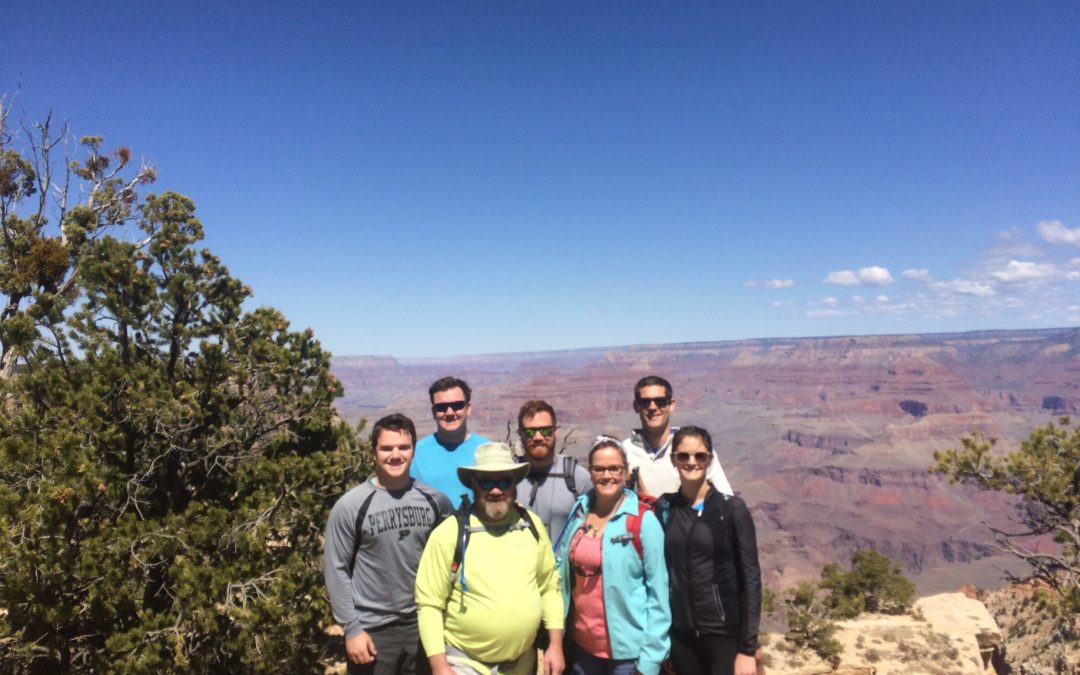
by The Goat | Aug 27, 2019 | Grand Canyon, Hiking
Hiking in the Grand Canyon is truly a humbling, inspiring, jaw-dropping, fantastical, enlightening, and (insert hyperbole) experience. Even a simple stroll along the rim of this national treasure is sure to conjure existential feelings that may stir your very being. However, you may also find yourself confronted with so many choices that it could seem overwhelming. Although it’s impossible to make a wrong choice in Grand Canyon in terms of hiking choices, it is helpful to have someone that can narrow it down for you. Here is The Goat’s Top 5 Day Hikes in Grand Canyon National Park.
5. Bright Angel Trail to Indian Gardens
The most popular trip in the park, and one of the most famous day hikes in the world is the Bright Angel Trail to Indian Gardens. Tracing the Bright Angel Fault, the central canyon’s most important structural feature, the trail is excellent for first-time canyoneers. Indian Gardens, named for the fact that it sustained Ancestral Puebloan peoples for thousands of years with its natural perennial spring and shaded riparian area, fabulous on hot days in the summertime.
Length: 6 miles round-trip
Difficulty: Moderate
Season: Year-Round, though midday in summer requires an early start
4. Wildforss Trail to Wildforss Point
This grand North Rim hike is perhaps the finest hike in the Grand Canyon that does not take its travelers below the rim. Named after Gunnar Wildforss, an artist who became enamored with painting the Grand in the 1920’s and 30’s using pastels and watercolors, the Wildfires Trail gives treats it hikers to fabulous views of the splendor of the North Rim from the Kaibab Plateau. Clear days on this trail yields views all the way to the San Francisco Peaks near Flagstaff, nearly 80 miles away as the crow flies.
Length: 9.8 miles
Difficulty: Moderate
Season: May-October
3. Grandview Trail to Horseshoe Mesa
Though challenging, not to mention a bit toasty in the summer heat, this is simply one of the most outstanding hikes not only in Grand Canyon, but in the entire National Parks system. From Grandview Point, which lives up to its name, hikers are treated to views of two monoclines (folds in the Earth’s crust) and sweeping Grand Canyon Vistas. A short side trip down the Redwall leads to the most successful mining claim in all of Grand Canyon, where some mining equipment and tunnels are left intact. Lunch on Horseshoe Mesa is simply sublime.
Length: 6.5 miles
Difficulty: Strenuous
Season: Year-round, though summer requires an early start
2. Hermit Trail to Dripping Springs
The best thing about this hike? A fabulous lunch spot under a cave canopy of delightfully misty spring water. Beat the crowds that flock to Bright Angel and South Kaibab trails by taking the shuttle out to Hermit’s Rest and hiking down the Hermit Trail. Dripping Springs also represents a fabulous opportunity to see the geologic forces that are responsible to carving Grand Canyon up close and personal.
Length: 6.25 miles
Difficulty: Moderate
Season: Year-round, though summer requires an early start
1. North Kaibab Trail to Roaring Springs
We’re a bit partial to the North Rim here at Blue Marble Adventure GeoTourism, but that doesn’t make The Goat’s opinion on this one biased in the least. North Kaibab to Roaring Springs is just the best day hike in the Grand Canyon, period. Avoid the crowds of the South Rim and South Kaibab while enjoying spectacular and contemplative North Rim scenery. Sound good? It gets better. The North Rim’s only maintained trail is also the most approachable for first-time Grand Canyoneers, making it a particularly recommendation-worthy hike indeed.
Length: 10 miles
Difficulty: Strenuous
Season: Year-round, though summer requires an early start
The best way to experience everything that these hikes have to offer is with one of our expert geologist/guides, who will introduce you to the intricacies and secrets of the rocks in Grand Canyon, as well as history, culture, and everything that makes Grand Canyon so grand. Call us today!
Going Guided
Hiking and exploring Grand Canyon, or any of the National Parks, is a special experience. Although it is possible to see these places yourself, hiring a guide is a great idea. For instance, guiding services provide logistical support, and plan everything for your best possible trip. They provide a great safety net on the trail, and are trained in backcountry medicine. Above all, they provide a depth of knowledge of the region that turns a walk into a true adventure.
Blue Marble Adventure GeoTourism provides all of the support you need, and pairs that with expert geologist/guides. Our backcountry meals use fresh ingredients, and are planned by a professional chef. Furthermore, we provide top-of-the-line gear and passion for the places we explore. In conclusion, you can visit National Parks, but going with a guide can create and even more memorable experience. Don’t be shy, and call us!
Read our blog!
For adventure hiking vacations in a geologic time machine, see our epic tours in Grand Canyon, Utah, and Arizona!
For geological musings read The Goat’s geology blog.
Follow us on Facebookand Instagram
Explore Further, Be Wild, See Through Time — Blue Marble Adventure GeoTourism
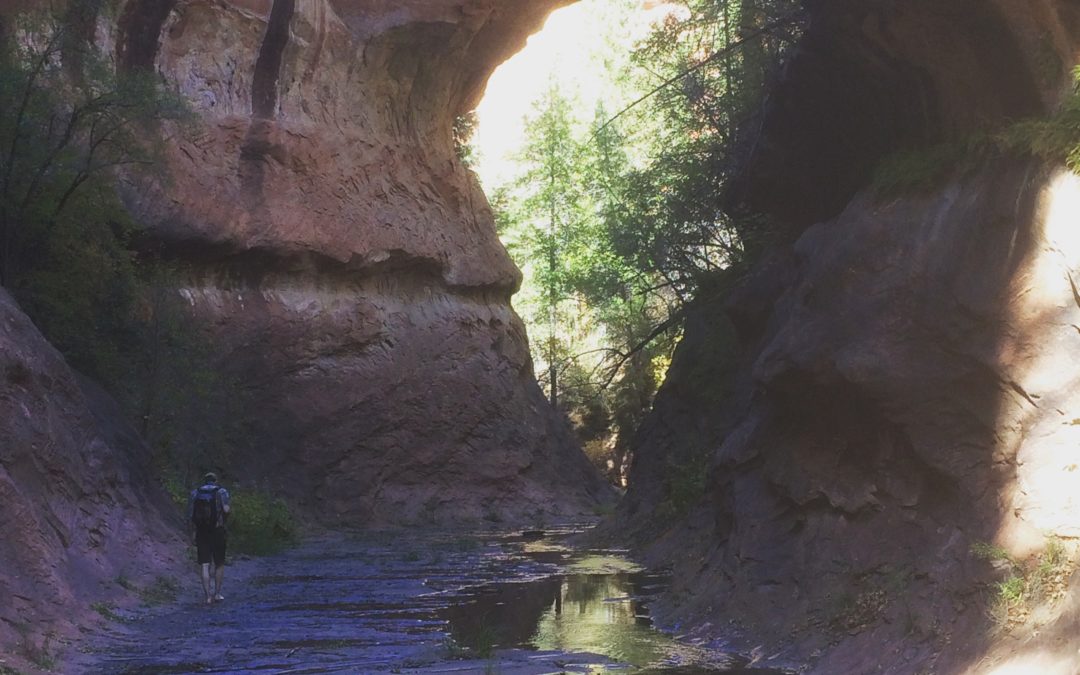
by The Goat | Aug 27, 2019 | Hiking
How to Stay Cool in Grand Canyon
“We knew it would be hot, but we didn’t think it would be this hot.”
–Blue Marble Adventure GeoTourism guest near Phantom Ranch in Grand Canyon
Though this particular guests’ quote is their own, variations of this are heard regularly on the trail, not only on our tours, but in general. The heat of the southwest can be downright oppressive, almost stifling during midday heat in the summertime. Many of Blue Marble’s hiking tours in Grand Canyon, Utah Canyon Country, Death Valley, or Havasu Falls are in the arid southwest, where 90 degrees in early April is routine, and triple digits are seen quite often during the popular summer months. If your timing is a bit off, if you are a desert hiking novice, or you simply underestimated the heat of the midday, this article is for you.
Many folks choose to hire a backpacking or hiking guide for just this reason; they can quite simply be the difference between the ultimate adventure of a lifetime, and a perilous rescue situation. As you explore our wonderful desert paradise here in the American Southwest (with us or without us!), our Goat wants to be sure that you are doing it safely, and that your unforgettable adventure is unforgettable for all the right reasons!
With the busy hiking season approaching, The Goat thought it best to dole out his best tips and tricks for staying cool, even when it seems impossible. Here are our Top 3 ways to beat the heat on the trail:
1. Early Boots Get the Worm
We are often on the trail as early as 4am during the warm months, and no later than 6am. Does this seem like some ungodly hour? It does to us too, but you will see the benefits later in the day. An early start allows you to not only beat the heat, but you will also typically have the trail to yourself, have a better chance to see wildlife while you’re hiking, and be relaxing in camp instead of hiking during the heat of midday. Trust us; it may seem ridiculous when it’s that early, but there’s no doubt you will swear by it soon enough.
2. Don’t Flip, Take a Dip
When you see water, get in. Most water that you find along the way in the southwest is there because it’s in shade, it’s seeping from the ground, or it’s about to be gone. Being wet in the southwest is a very good thing, as our legendary dry air quickly evaporates moisture, creating a great cooling effect. Ever wonder why everyone in Arizona has a pool? Maybe they’re onto something.
3. Just Eat It!
Many people grossly underestimate how much food they need when its warm; problem is, you don’t really feel hungry when it hot outside. However, you need to keep eating, as it both fuels your body’s natural cooling abilities, and can help you regulate your fluid intake. Interestingly hyponatremia, or a glut of water, is a leading cause of wilderness debilitation and happens nearly as often as dehydration. Be sure to eat plenty of food, and regulate your water intake at a healthy pace.
All of our guides are medically certified as Wilderness First Responders, and have years of backcountry experience that can be invaluable to you as a backcountry traveler in recognizing symptoms of hyponatremia, dehydration, heat exhaustion, and even heat stroke, which can be a serious issue. What’s great here is, all you need to do is engage in what is likely already a favorite activity; snacking!
With these three things in mind, you will get a great jump on a fabulous time in the wilderness, and not need to worry about running into a potentially shady (or un-shady as it might be) type of situation. See you on the trail!
Going Guided
Hiking and exploring Grand Canyon, or any of the National Parks, is a special experience. Although it is possible to see these places yourself, hiring a guide is a great idea. For instance, guiding services provide logistical support, and plan everything for your best possible trip. They provide a great safety net on the trail, and are trained in backcountry medicine. Above all, they provide a depth of knowledge of the region that turns a walk into a true adventure.
Blue Marble Adventure GeoTourism provides all of the support you need, and pairs that with expert geologist/guides. Our backcountry meals use fresh ingredients, and are planned by a professional chef. Furthermore, we provide top-of-the-line gear and passion for the places we explore. In conclusion, you can visit National Parks, but going with a guide can create and even more memorable experience. Don’t be shy, and call us!
Read our blog!
For adventure hiking vacations in a geologic time machine, see our epic tours in Grand Canyon, Utah, and Arizona!
For geological musings read The Goat’s geology blog.
Follow us on Facebookand Instagram
Explore Further, Be Wild, See Through Time — Blue Marble Adventure GeoTourism














